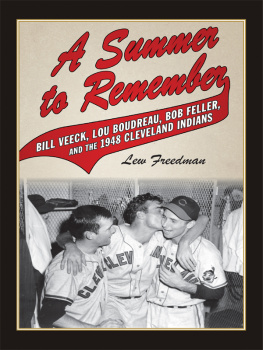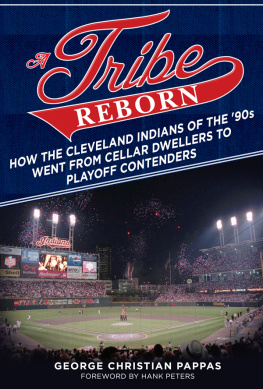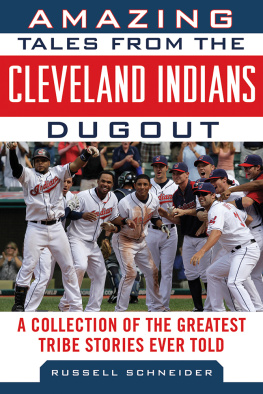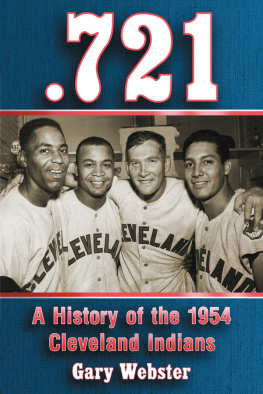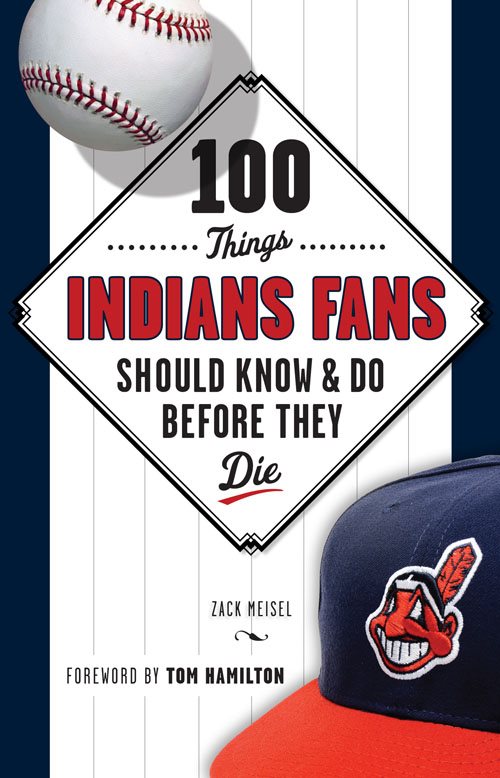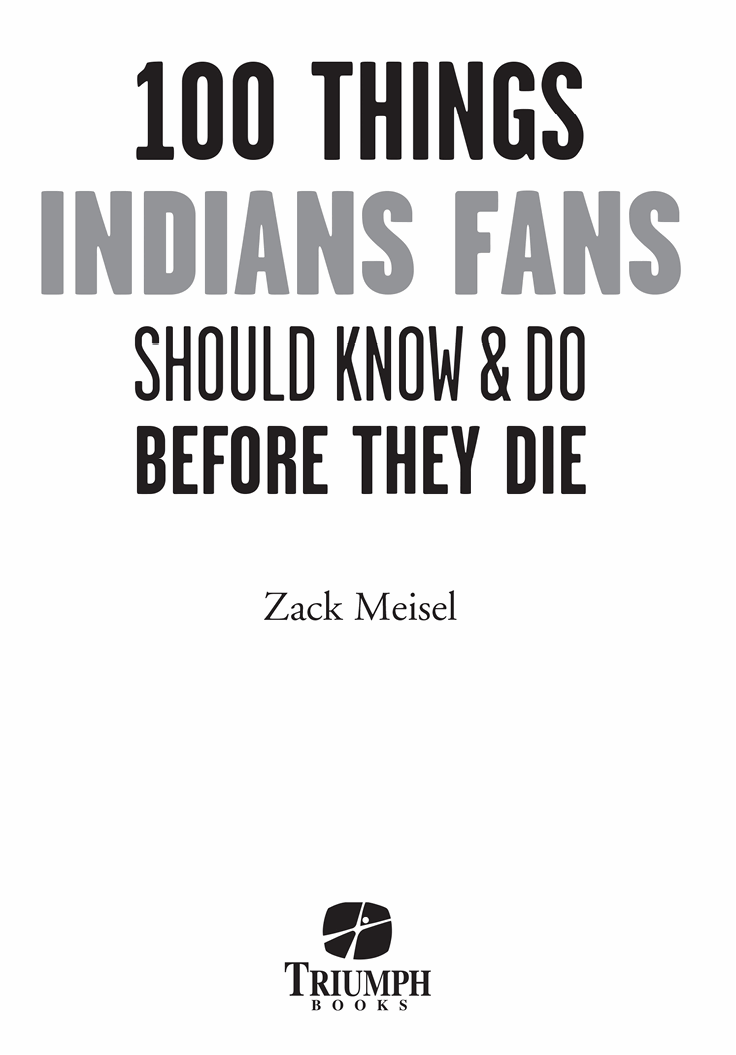
For my late father, Jeff, and for my late grandmother, Joyce, who only had an interest in baseball and in the Indians because her grandson was writing about those topics. We couldnt even begin a meal at the hole-in-the-wall Chinese food joint near her house without her flooding my brain with story ideas, most of them outrageous and unrealistic and all of them appreciated. Im sure she would have contributed every thought she could muster as I composed this book.
And for my mother, Wendy, who has forever begged me to acknowledge her baseball acumen, which she claims rivals that of any other mother. If only this were a book about Don Mattingly or Greg Maddux.
Contents
Foreword by Tom Hamilton
I wish I would have been good enough as a player to have played at this level, but I wasnt. So for me, becoming the radio announcer for the Indians was the next-best thing to being a major league player. There are only 30 of these jobs and I was one of the lucky ones who got one of the 30. The odds of that arent very good for a guy who grew up on a dairy farm in Wisconsin.
Listening to Milwaukee Braves games and then the Brewers when I was growing up, this job seemed like the impossible dream but it became a reality. I cant quite get over the fact that it really happened. From a professional standpoint, the Cleveland Indians mean everything to me. I cant think of a better organization to have worked for. We cant think of a better city to have raised our four children. We came here with a two-month-old and now have four children and we never had any thoughts of going anywhere else. We had other opportunities, but never seriously considered them because we thought that much of the organization and the city.
I know how blessed we have been to get this opportunity and to have witnessed a ballpark that helped revitalize a city, a ballclub that ended all of the national jokes about Cleveland. You think of this ballpark and those teams in the 90sthat was the end of late-night talk shows taking shots at Cleveland. It ended it. To have seen all of those great moments and the great Hall of Fame players who have played here, Ive been really blessed.
You never know how fans are going to take you. I think I was really fortunate that I worked with Herb Score for eight years, since Herb was such an icon. Because Herb accepted me, that opened the door for fans to accept me. It was very fortuitous to be able to work with Herb.
You want to work in a city where the fans care. The worst thing is apathy. Florida has great weather. So do California and Atlanta. But in a lot of those places, those people didnt grow up with those teams. They moved to those cities, so they may be fans, but they dont live and die with it like they do here in Cleveland and some of the other Midwest cities.
I always wanted to live in the Midwest, as did my wife. We wanted to raise a family in the Midwest because we believe in those values. But also, the fans care so much. If fans care, it cant help but make you be a better broadcaster. You may have a bad season, but you know how much they care for that nights game.
This job has given us a great life. We owe everything to baseball. The home we live in, the ability to send our kids to collegewe owe all of that to baseball. Outside of my family, nothing means more to me than what the Indians have meant.
Tom Hamilton
Introduction
I was eight years old, a third-grader at Parkside Elementary School with few interests other than playing outside, watching Hey Arnold! , eating chicken fingers, and following the Cleveland Indians. I had no idea that one of those hobbiesnot the chicken fingerswould provide the fuel for the activity that eventually became my career.
On April 15, 1998, the Indians hosted the Seattle Mariners at Jacobs Field. In the third inning, menacing Mariners southpaw Randy Johnson buzzed a fastball near the head of Tribe leadoff man Kenny Lofton. Tempers flared, benches cleared and, temporarily, cooler heads prevailed. Johnson returned to the mound. Lofton settled back into the batters box. And then it happened again. Johnson fired a heater in nearly the same location. The benches cleared again and both players were ejected.
I had never seen anything like it. I witnessed the Indians World Series misstep six months earlier and the theatrical journey they traveled to arrive at that point. But I had never seen this element of the game, one with so much attitude and passion. At school the next day, I wanted to discuss the events with my friends and classmates, but they were more intent on learning multiplication or watching Bill Nye the Science Guy . So, I wrote about it. I recapped what I had watched unfold. In a way, it was a third-grader penning a game story, a type of writing I would repeat hundreds of times later on in my life. I wasnt assigned to write anything. I just wanted to. A handful of years later, when I felt the urge to take a high school journalism class, that sequence appeared in my mind. I wasnt aware at the time, but even as a little kid, I wanted to be a sportswriter. Of course, accepting the fact that my 72-mph fastball wouldnt cut it in the big leagues certainly helped me reach that conclusion a bit more swiftly.
When I was asked to write this book, the task seemed somewhat surreal at first. Eight-year-old me would have been just as eager to attack it as I was when I actually received the inquiry. A native Clevelander, I grew up during the golden era of Indians baseball. For the first part of my life, sellout crowds, household names, and memorable Octobers were all I knew. I was spoiled. Still, it never really seemed crazy that I ended up covering the Indians. It just felt right. And to write a book about their history just reinforced the connection I have had with the team since my childhood.
I have had the opportunity to interview and get to know many of the players, coaches, and executives I grew up idolizing. Those relationships are quite different now; I dont wear my youth-large Jim Thome T-shirt when I interview him. Now, its no big deal to sit in Robbie Alomars suite at the Rogers Centre in Toronto and ask him about his relationship with his brother. Sandy Alomar Jr. and I have spent hours reminiscing about his magical 1997 season and analyzing why his little brother always picks up the tab when they share a meal.
The main thing I have learned during my years covering the Indians is that many who have spent a decent amount of time in the organization will speak passionately about it. The Indians were a charter member of the American League in 1901. Since then, there is enough history to fill thousands of pages. Speaking to current and former players and coaches and front-office bigwigs about the more than 100 years of moments and memories and personalities has been a privilege. To an eight-year-old in April 1998, the Johnson-Lofton feud was the most essential event in franchise history, but in reality, its just one tiny, tiny blip on the radar. Here are 100 of those more pressing and memorable moments, personalities, events, and activities.
1. The Rebirth of the Franchise
The Indians were set to host an open house at newly minted Jacobs Field on April 3, 1994, a Sunday afternoon. It snowed. The event was canceled.
It was not the most promising omen for the grand opening of a new ballpark set to happen the next day.
The Friday before Opening Day, the Indians dedicated a statue to Hall of Fame pitcher Bob Feller outside of Gate C, out beyond center field. A day later, the Indians and Pirates squared off in an exhibition game intended to serve as a test for ballpark operations. Fans poured into the stadium until it was packed to near capacity.


